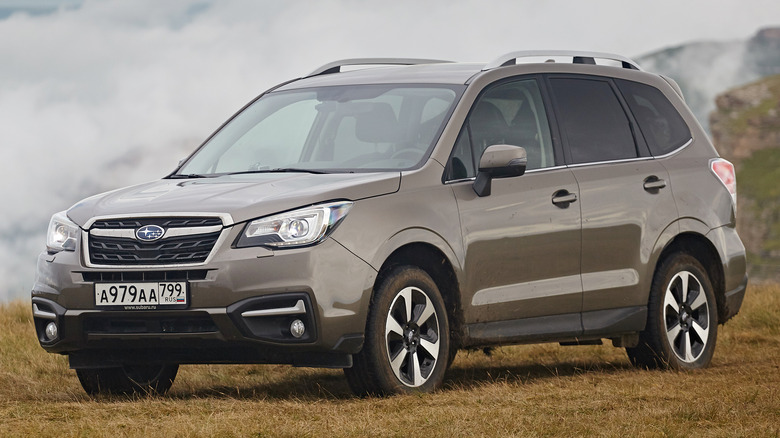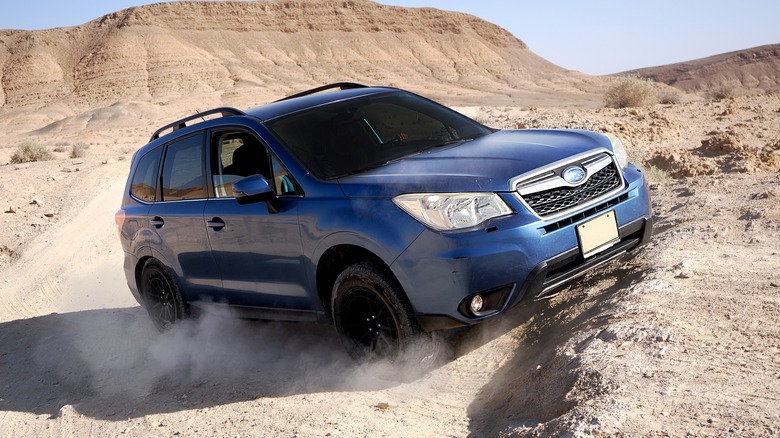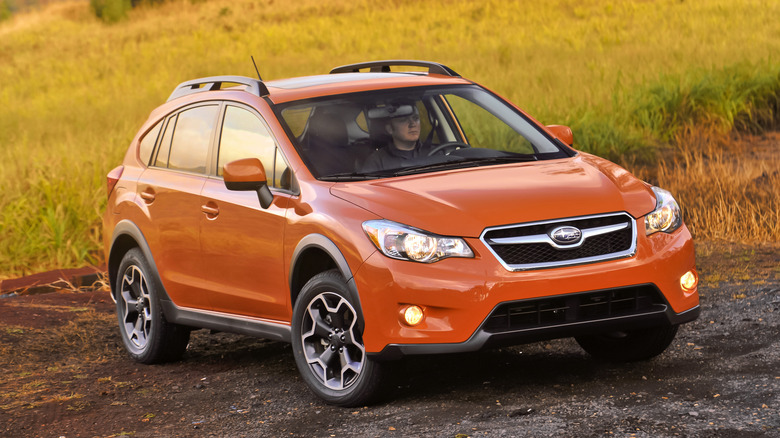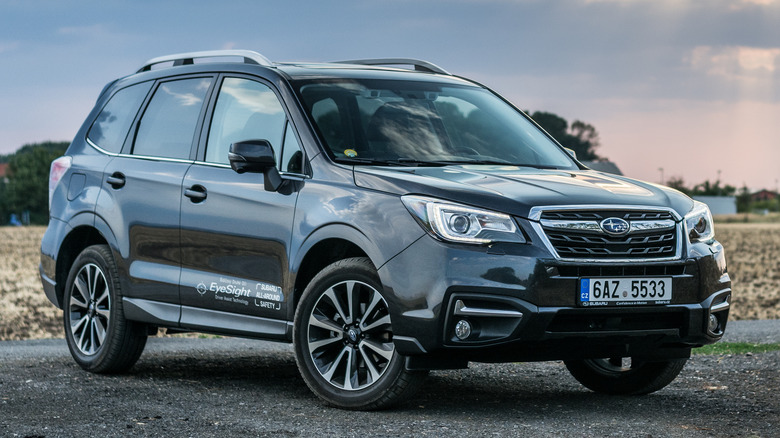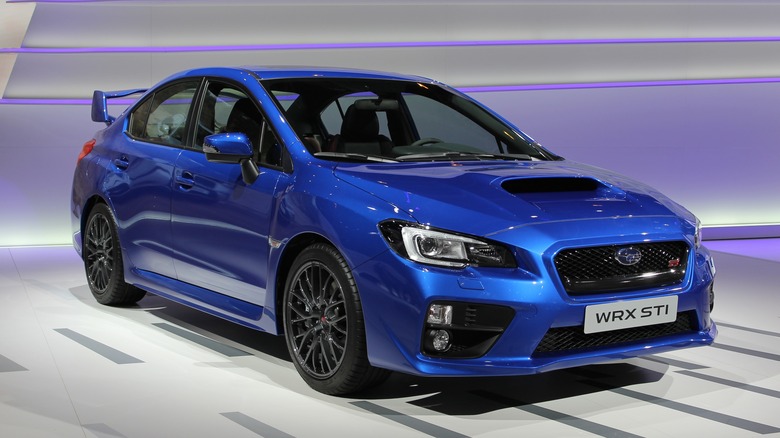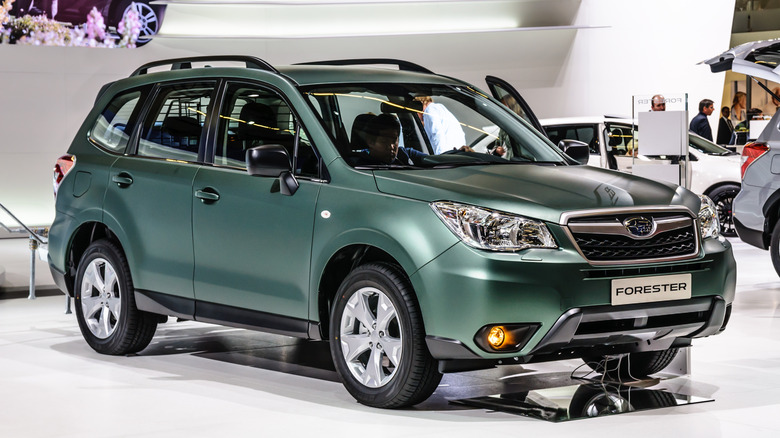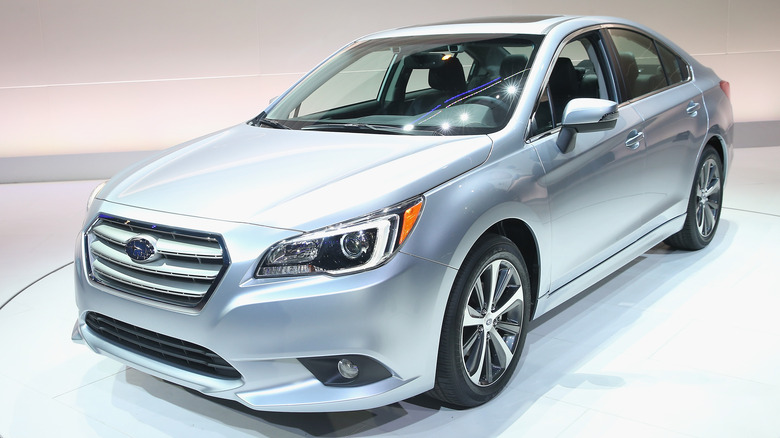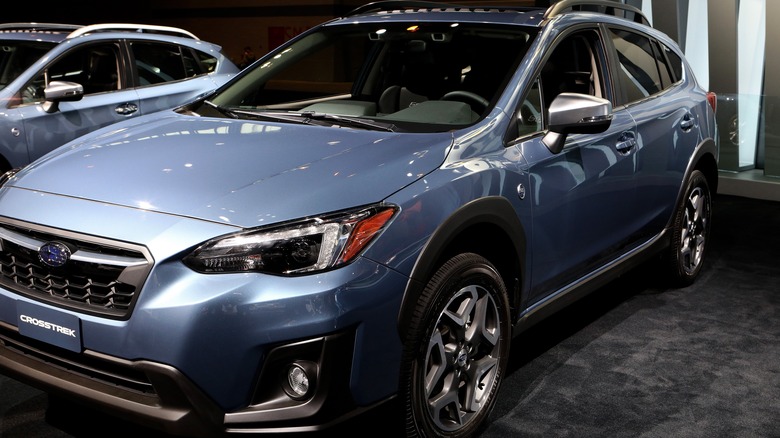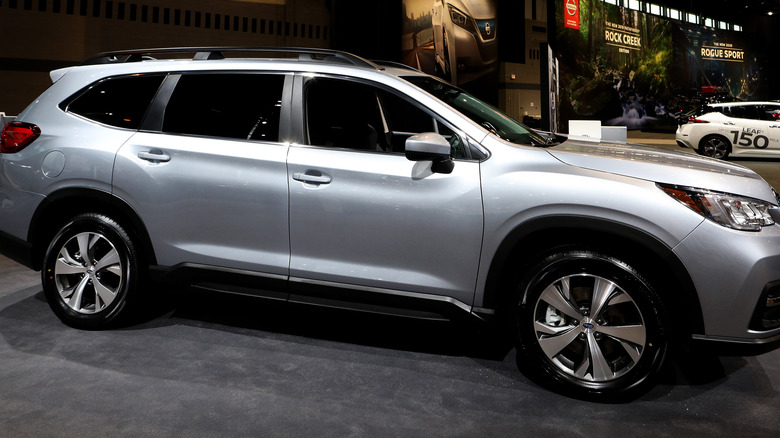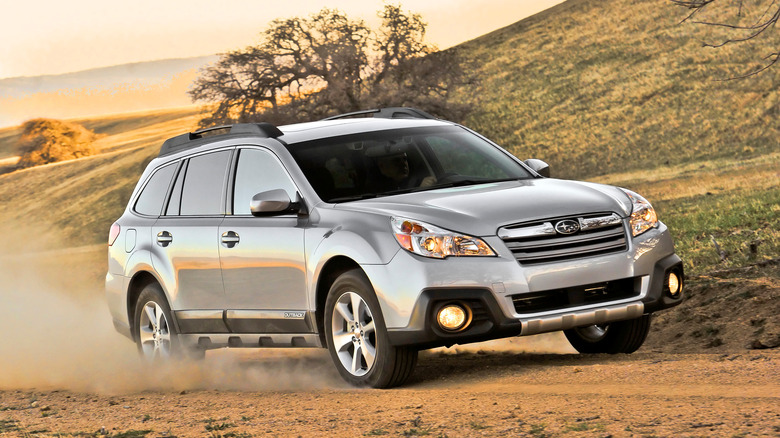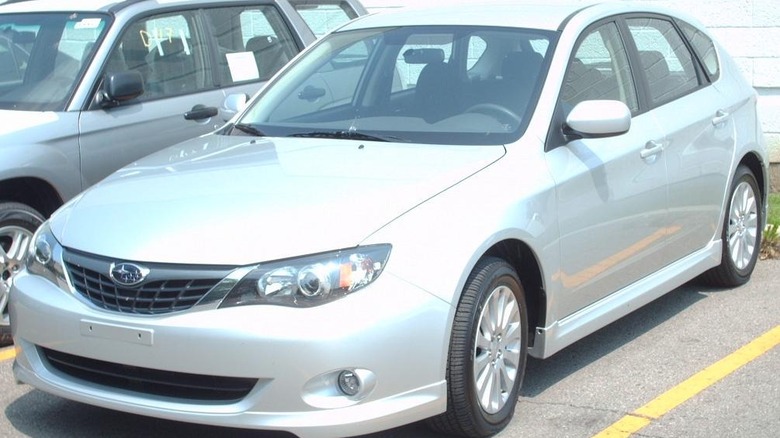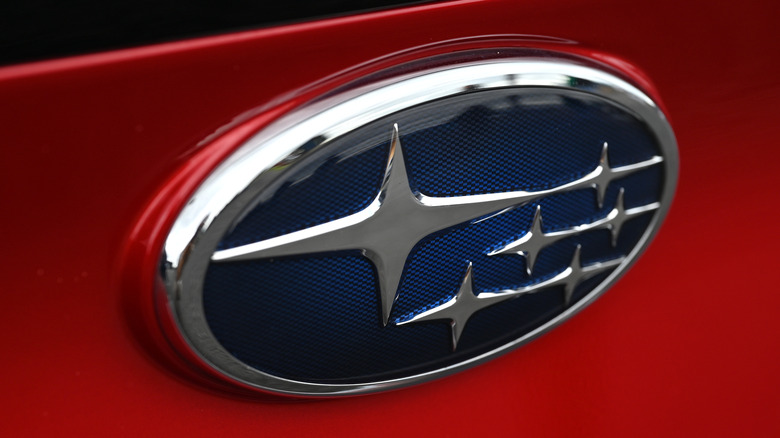10 Used Subaru Models You Should Steer Clear Of At All Costs
Subarus have earned a reputation for being tough, reliable, and capable vehicles, particularly when it comes to tackling challenging terrain and harsh weather conditions. With their signature boxer engines and symmetrical all-wheel-drive systems, these Japanese cars have developed a cult-like following among outdoor enthusiasts and adventure seekers. However, like any other automaker, Subaru has had its fair share of hits and misses over the years. From recurring mechanical problems to questionable design choices, certain used Subaru models have earned a notorious reputation for being more trouble than they're worth.
One such model is the Subaru SVX, which was produced from 1992 to 1997. Despite having a super unique design by the legendary Italian car designer Giorgetto Giugiaro and packing a punchy 3.3L flat-six boxer engine, the SVX just didn't catch on. It cost way more than other Subarus at the time, and the automatic transmission wasn't exactly great. All that led to really low sales — only about 14,000 SVXs found buyers over its whole run.
When it comes to buying a used Subaru, the stakes couldn't be higher. Choosing the wrong model could lead to years of frustration, costly repairs, and a lingering sense of regret that just won't go away. That's why SlashGear has done the heavy lifting for you. We've compiled safety data from the NHTSA, including recalls, active investigations, and consumer complaints, to create a list of model years worth steering clear of if a reliable used Subaru car is what you're after.
2014 Subaru Forester
Car Complaints reports that an alarming number of 2014 Subaru Forester engines show excessive oil consumption and total engine failures requiring very expensive repairs or total engine swaps. This not only means a huge financial blow to your wallet but raises fair doubts about how long this vehicle will last.
The suspension also has troubles that could put your safety at major risk. Specifically, the rear coil springs have shown a scary tendency to suddenly snap without warning, taking steering and stability away in an instant. While new springs might fix it, the fact this keeps happening and could cause accidents makes it a real threat worth paying attention to.
As if that's enough, the transmission in the 2014 Forester has encountered issues ranging from the drive feeling rough to clutches failing due to struggles with shifting — really impacting the ride quality and ability to trust the vehicle. Electrical gremlins also plague this model. Blown fuses, faulty warning lights, and other glitches that crop up can be a real bear to track down and expensive to fix.
So far, the NHTSA has issued two recalls for this model year — one for brake lights that may not work right and another due to curling floor mats that could block the gas and brake pedals. No one wants to wonder if they can stop in time.
2013 Subaru XV Crosstrek
The 2013 Subaru XV Crosstrek has been subject to two recalls by the NHTSA. The first involved a potential issue with the engine valve springs, which, in rare cases, could fracture under high mileage. Should the springs break, it could disrupt engine operation and even cause a stall. The second recall addressed a concern with the optional remote engine start function. If the key fob was accidentally dropped from a certain height, it appeared the device could malfunction by mistakenly transmitting an engine start command even without the button being pressed.
However, Cars Complaints found that one of the most alarming issues you may experience with this car is its dangerous steering behavior in snowy, slushy, or icy conditions, which could easily lead to accidents. While rare, one unique issue reported by an owner on SubaruXVForum involved a disconcerting feeling when turning right. After investigation, the cause was found to be a cracked aluminum casing surrounding the electric steering rack mechanism, which allowed moisture to interfere with rack operation.
A number of 2013 Subaru Crosstrek owners have noticed excessive engine oil consumption. Some have said they need to top it up between scheduled changes, while an unlucky few have even experienced total engine failure as a result of this. On top of that, this car struggles with wheel bearing failure, which can cause the wheels to lock up, making the car difficult to control and significantly increasing the risk of collisions.
2018 Subaru Forester
If you are looking to buy a used 2018 Subaru Forester, be ready to deal with a cracked windshield, which may happen sooner or later due to impacts or temperature changes. Not only does a cracked windshield look unappealing, but it can also mess with the EyeSight driver assistance system. That means it has to be recalibrated, and according to Cars Complaints, repairs typically cost around $930 on average.
Over time, exhaust manifold leaks can become noticeable, with louder noises from under the hood and engine performance taking a hit. Fixing or replacing a leaky exhaust manifold runs around $1,500. Some 2018 Subaru Forester owners report unpredictable steering at higher speeds, possibly from tire imbalances, flat tires, tire damage, curved rims, rough tires, and loose nuts. Some owner reports to NHTSA also talk about airbags not going off in an accident and about the passenger airbag turning off even when someone's sitting there. In other situations, the airbag warning light may come on, pointing to a possible issue with the system.
A couple of other minor problems that plague this model's interior are busted backup cameras and noisy dashboards. Backup cameras might stop working due to software glitches, broken parts, or a blown fuse in the fuse box. The dash noise may stem from loose components and rattling around or suspension-related issues. Fixing those types of electronics and vibration problems can be frustrating and each repair adds up.
2015 Subaru WRX
Per owners' reports on Cars Complaints, the 2015 Subaru WRX has problematic clutches. A number of drivers have noticed slipping clutch pedals or ones that don't feel quite right. Unfortunately, fixing the problem often requires spending around $1,600 to replace worn parts like the clutch plate and flywheel.
According to the mechanics at Tuning Pro, there are a few common issues to keep an eye on with these WRXs. The engine can sometimes run into problems with the pistons, rods, rings, and bearings. Oil leaks also tend to crop up quite a bit with these cars, which are hardly unique to Subarus, and some drivers mention their car starts misfiring occasionally — evidenced by rough idling — which could point to developing problems deeper in the engine. Furthermore, there are complaints about transmission problems. The worst complaints are throw-out bearing noise, the vehicle getting stuck in neutral, and the vehicle not shifting into second gear.
A few other issues crop up, too. A number of drivers have had trouble with the AC and heating not working as they should. The turbocharger faces premature stress in high-output WRXs like the 2015 STI model. Its brawny 2.5L boxer engine unleashes a stout 305 horsepower rating, well above the regular WRX's 2.0L engine. However, this extra grunt from the STI's forced-induction 2.5L powerplant could potentially overload the standard single turbo over longer periods of vigorous driving.
2015 Subaru Forester
Owners of the 2015 Subaru Forester have reported some concerning problems. One issue that frequently comes up involves the engine. As discussed on Cars Complaints, aside from excessive oil consumption, several accounts mentioned failures and sudden loss of power while driving at highway speeds. This seems to particularly affect the 2.0XT models, which Subaru recalled due to a faulty turbocharger air intake duct that could crack and cause stalling, upping the risk of accidents.
Brake safety is another major worry. According to NHTSA, one of the three recalls Subaru issued was to address a defective brake light switch that might prevent brake lights from turning on, posing risks to the driver and surrounding traffic. On top of that, some owners complained of electrical glitches like issues with starting the engine and parasitic battery drain. In addition, Foresters equipped with the Lineartronic CVT frequently have problems. Reported issues included shuddering at low speed and eventually total failure. Subaru acknowledged these problems in a service bulletin provided to NHTSA, mostly blaming insufficient transmission fluid.
In addition to the main issues above, 2015 Foresters face other niggles, such as Bluetooth connectivity not working, unintended acceleration, and AC failing suddenly.
2015 Subaru Legacy
After 35 years of success, Subaru has announced that the Legacy nameplate will be discontinued after the 2025 model year – the end of an era for a model that has had its share of quirks and characteristics.
One such characteristic is seen in the 2015 Subaru Legacy, which is famous for burning through oil a bit quicker than expected. The most likely suspects for this issue are worn seals and gaskets letting oil escape all over, poor quality oil that doesn't last as long, and worn piston rings allowing oil to drain into the combustion chamber, among several other reasons. As a result, you may notice the car may give off a burning smell, which could indicate a few other issues under the hood.
Some 2015 Subaru Legacy seem to have some quirks with the gearbox. MyCarSpecs reports that the most frequent issue is the fluid levels running a bit low because of leaks somewhere in the transmission. Usually, the seals inside the transmission or drive shaft wear out a tad and start weeping fluid over time. Other pesky troubles involved grumpy torque converters, faulty solenoids not doing their job, or worn-out clutches. The end result of this is often trouble shifting between gears — it might feel sticky or make funny noises, cause vibrations you could feel, and ultimately lose some peppiness.
On Cars Complaints, the body and paint were the most frequent issues, with things like wind noise getting in, gravel getting stuck in the undercarriage, and paint peeling. Finally, the fuel system may have issues with the gas door not opening or the fuel history readout being off.
2018 Subaru Crosstrek
The Crosstrek has become one of Subaru's most dependable vehicles over the years. However, the 2018 Subaru Crosstrek falls short of that hype. According to Cars Complaints, one of the most widespread complaints is the freezing stereo system, which can start acting up as early as 15,000 miles. While software updates may help, this frustrating issue can persist, leaving you without music or navigation during your drives.
But that's just the tip of the iceberg. Owners have also reported losing traction due to the rear suspension sliding easily and the alignment continuously being out of spec. Cosmetic issues also abound, with the paint chipping off within the first 5,000 miles, the fog light shroud falling off, and water leaking from the eyesight housing. Then there's the cracked windows and windshield plague, a widespread problem across multiple Subaru models, including the Crosstrek.
In 2019, Consumer Reports reported a recall involving around 83,000 Subaru Ascent vehicles from the 2018 model year due to faulty positive crankcase ventilation (PCV) valves. The defective PCV valves could potentially allow engine oil to enter into the combustion chamber or even cause valve components to break off and enter the engine.
According to the NHTSA, the automaker issued recalls for rear stabilizer bar bolts that could loosen and detach, radio sound problems after starting the vehicle, which required a soft reset to resolve, and a recall related to the accelerator pedal.
2019 Subaru Ascent
On a positive note, the 2019 Subaru Ascent is definitely Subaru's biggest SUV yet. You can get it with either seven or eight seats, both of which come with all-wheel drive, as expected from Subaru. However, it has been subject to eight recalls from NHTSA for various defects, including some involving electrical system wiring, powertrain driveline chain/belt, fuel pump, crankcase and engine cooling/exhaust, and automatic transmission control module.
Owners on Cars Complaints have reported problems with the electrical system. One common issue is the battery draining if you leave the tailgate open for too long, making it harder to start the engine. Now, this drain could happen as the battery gets older and loses juice or if there are hiccups with the alternator not charging it properly. Quite a few Ascent drivers have also reported issues with the in-car features like navigational headaches, voice commands not working as intended, and CarPlay struggling to read texts out loud.
In terms of performance, the CVT transmission comes with a bit of a headache. Quite a few owners have reported weird noises and slippage problems, especially when cruising on the highway. For some unlucky owners, the issues have been so bad that they've had to fork over a lot of money to fix or get the entire transmission replaced. It is also prone to sudden brake failure, warped rotor, and brake noise. Some owners have even reported severe shuddering and vibrations when braking on steep downhill grades on Ascent Forums as a result of premature brake pad and rotor wear.
2014 Subaru Outback
A number of 2014 Subaru Outback owners on Cars Complaints have reported hesitation when accelerating in the 2014 Subaru Outback, typically occurring around an average mileage of 15,000 miles. The hesitation is often described as a momentary lack of response from the vehicle when the gas pedal is pressed. The car may seem to stutter before finally accelerating from a stop or near stop. There is also the issue of excessive oil consumption, which may be related to the piston ring tension not being set right, allowing oil to slip past the rings and burn up in the combustion chamber.
Some drivers have also noticed shuddering while shifting gears, particularly during light acceleration between gears. This issue seems more obvious when the CVT changes gear ratios at very low speeds. Replacing burnt-out headlight units on the 2014 Outback has also proven difficult, as the bulbs are not easily accessible. This is concerning because Vehicle History reports that many Outback models get burnt headlights within the first 50,000 miles, and replacements continue burning out every 10,000 miles or so. The headlight ballast may be defective, contributing to the frequent burn-outs.
According to NHTSA data, the 2014 Subaru Outback has had ten recalls, including issues with the parking brakes, ignition switch, windshield wiper motor, parking rod detachment, and airbags.
2008 Subaru Impreza
NHTSA data shows that the 2008 model stands out as one of the most problematic years for the Subaru Impreza, with 15 recalls issued. Subaru had to recall over 199,000 vehicles from 2008 to 2011 – including the 2008 Impreza — for a second time to address rusty brake lines. This issue was due to salty water splashing up through a gap and onto the brake lines, causing rust and leaks over time.
However, Car Complaints reports that the most serious complaints of 2008 Subaru Impreza owners are related to the head gasket leaking. This can lead to overheating, poor engine performance, and, eventually, engine failure. The average repair cost for this issue is reported to be over $2,000. Another frequently reported trouble spot is issues with the clutch assembly. Some drivers noticed a popping sound when pressing the clutch pedal. If the bearing connecting the clutch goes out, it can start squealing or making grinding noises when you shift gears. Even worse, it could make manually changing gears very difficult.
Many 2008 Subaru Impreza owners have noticed some visibility issues with the windows and windshield. They complain of a film that builds up on the glass over time, making it harder to see through, especially at night. Another nuisance reported by some owners is trouble with the sun visor. The sun visor can get loose and floppy, and in a few cases, reports have said the visor actually detached completely from its mounting, obstructing the view of the road.
[Featured image by Bull-Doser via Wikimedia Commons | Cropped and scaled | Public Domain]
Our selection methodology
In putting together this list, SlashGear drew on owner forums, reviews, and, most importantly, official data on complaints and recalls from the National Highway Traffic Safety Administration (NHTSA). While no car is perfectly reliable, high numbers of documented issues tend to indicate models where problems are more common.
Recalls, in particular, were a red flag since they involved identified safety issues that need addressing. Even if a previous owner got all recalls fixed as required by law, comments suggest some defects have a tendency to resurface later. Additionally, there's always a small chance work was skipped on a used car.
That said, most automakers have some lemons, and complaints usually come more from unhappy owners. Many Subarus remain popular for good reason, even at higher mileage.
